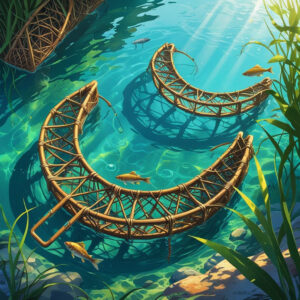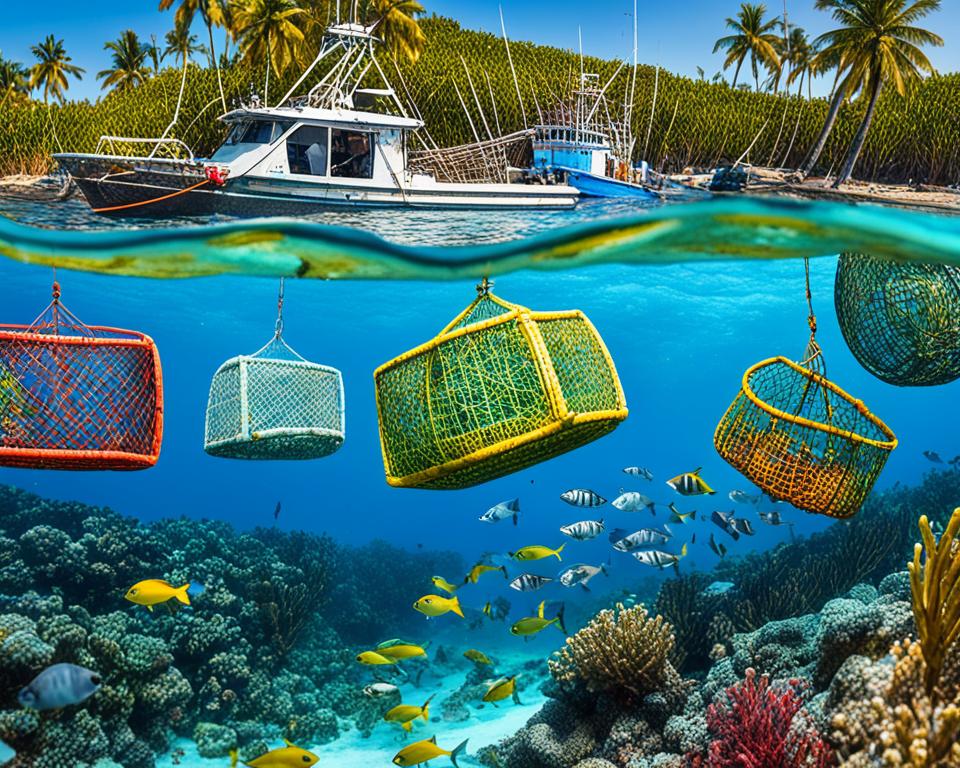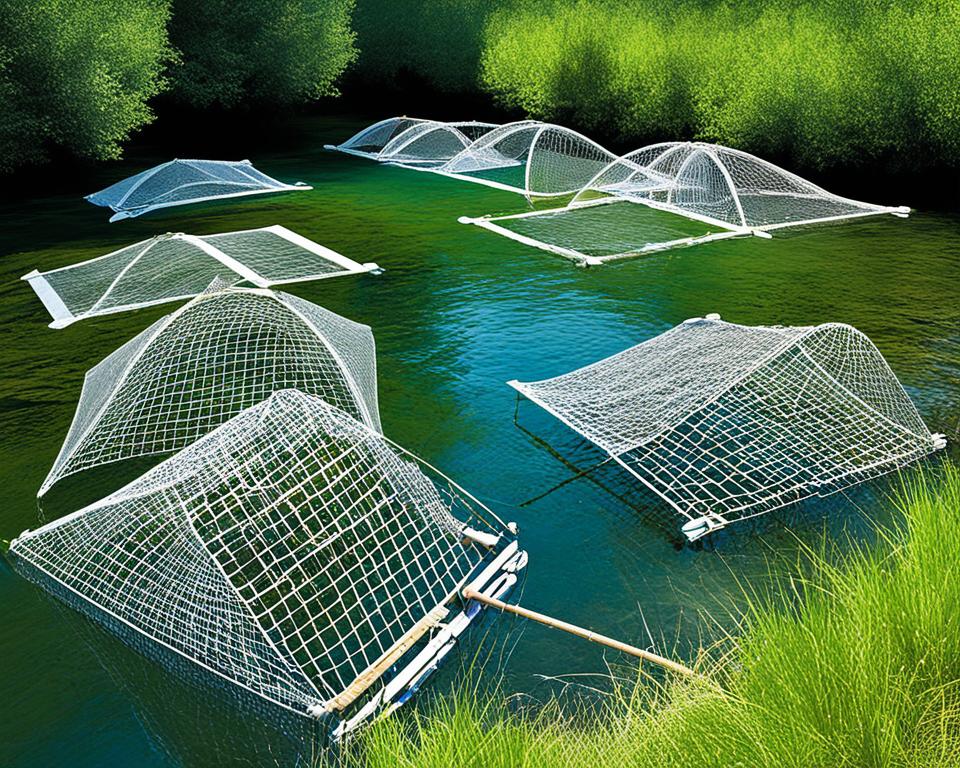Traditional to Modern Fish Traps: A Guide to Catching Fish Sustainably
Fish traps have been used for thousands of years as an efficient and eco-friendly way to catch fish without depleting resources.
From handwoven baskets used by early civilizations to modern wire and plastic designs, fish traps come in many forms—but all rely on the same principle: guiding fish into a container they can’t escape.
Whether you’re a survivalist, angler, or just curious about sustainable fishing, understanding the different types of fish traps—from traditional basket and funnel traps to advanced collapsible and automatic designs—can help you choose the best method for your needs while protecting aquatic ecosystems.
Key Takeaways
- Fish traps have been used for centuries, with historical and cultural significance in many coastal regions.
- The design and construction of fish traps varies, with V-shaped traps, circular stone traps, and other innovative designs employed.
- Trap fishing can be an effective method of catching a variety of fish species, but it also poses environmental concerns such as ghost fishing and bycatch.
- Regulatory frameworks and management approaches, including ecosystem-based fishery management, aim to address the sustainability of trap fisheries.
- Ongoing innovations in trap design and technology seek to reduce the environmental impact of this fishing method.
Introduction to Fish Trapping
Historical and Cultural Significance of Fish Traps
Fish trapping has been around for thousands of years. People made these traps from wood, stone, and woven stuff. They were made to fit the local area and the fish they wanted to catch. Fish traps were key for many coastal communities around the world.
Building fish traps was a big part of many cultures. People knew exactly where to put them to catch fish. This showed how well they knew their local waters.
Fish traps were more than just a way to get food. They were important for the culture and beliefs of the people who used them.
The story of fish traps shows how smart humans are at using nature’s resources. These traps have changed over time with new cultures and tech. But, the basic ideas of fish trapping are still important today.
They teach us about watching nature, making good tools, and keeping old knowledge alive.
“The design and placement of fish traps were not just practical, but also deeply rooted in the cultural and spiritual traditions of the communities that relied on them for sustenance.”
Looking into the different kinds of fish traps and how they’re used today, we see their deep history and cultural value. These devices remind us of the strong link between people and nature.
They also show why it’s important to keep traditional knowledge alive for the future.

V-Style Fish Traps
V-shaped or U-shaped fish traps are really cool. They have rock walls that guide fish into a basket or net. This makes them great for catching fish when they are spawning or feeding.
These traps were often built near the water’s edge on sandy areas. They used the shape of the land to their advantage. Archaeologists found many of these traps by ancient Lake Cahuilla in California. This shows how long these traps have been used.
The design of these traps is smart. The walls funnel fish towards the center. This way, fishermen could catch more fish easily. These traps were key for the food and economy of coastal communities.
Longshore weirs were different. They were built across the beach, trapping fish as they moved along the coast. These traps used the fish’s natural movement to catch them. This made fishing easier for the fishermen.
Using V-shaped traps and longshore weirs shows how ancient people were clever. Their fishing methods still inspire new ideas today. These methods help us manage resources in a way that’s good for the planet.
Circular Stone Fish Traps
By Lake Cahuilla’s shores, a special fish trap was found – the circular stone trap. These traps were made with strong rock walls. They were placed on the lake’s slopes. Some thought they were for hunting antelope, but they were likely fish traps.
Construction and Placement of Circular Traps
The circular stone traps were made to catch fish well. They were placed on the slopes to use the land’s shape. This helped fishermen catch fish easily.
The traps had a round shape and strong walls. This made sure fish couldn’t escape. The fishermen knew how to use the local materials well. They made traps that lasted a long time.
| Trap Type | Construction | Placement | Targeted Fish |
|---|---|---|---|
| Circular Stone Trap | Semi-circular to circular depressions with rock walls | Talus slopes along the lakeshore | Native fish species of Lake Cahuilla |
The circular stone fish traps show how clever ancient fishermen were. They made these traps with great skill. This helped them catch fish without harming the lake’s ecosystem.
Fish Trap Efficacy and Placement Strategies
The success of fish traps depended on their design and where they were placed. The shape, size, and mesh of the trap mattered. So did its spot near shorelines, water depth, and fish paths.
Old fishing groups used smart ways to place their fish traps. They tried different things to catch more fish. Here are some strategies they might have used:
- They put traps where fish often went by or hung out in big numbers.
- They used rocks or shallow spots to help fish swim right into the traps.
- They changed where they put traps with the seasons to match fish behavior and where they lived.
- They used many traps or different kinds to catch fish from all angles.
By thinking about what makes fish traps work best and where to put them, these early fishers caught a lot of fish. This helped feed their communities.
| Trap Design Feature | Impact on Trapping Effectiveness |
|---|---|
| Shape | Traps with V-shaped or circular designs were often more effective at guiding and retaining fish compared to simple box-like structures. |
| Size | Larger traps could accommodate more fish, but smaller traps may have been better suited for targeting specific species or size classes. |
| Mesh Size | Carefully selected mesh dimensions allowed the target fish to enter the trap while preventing the escape of captured individuals. |
Early fishing groups learned what made fish traps work best. They placed them smartly to catch lots of fish. This helped feed their communities.
Environmental Impacts of Trap Fishing
Fish traps can be selective but still affect the environment. They can harm benthic habitats like coral reefs and sponges. Also, trap lines and debris can trap and hurt marine animals, including whales.
Trap fishing can damage habitat. Traps go into delicate places like coral reefs, hurting marine life. Moving and repositioning traps can also harm the seafloor, damaging important habitats.
Lost or abandoned traps, or “ghost traps,” can catch and kill sea creatures for a long time. They can also damage habitats and trap wildlife. This is a big threat to the ocean’s health.
| Impact | Explanation |
|---|---|
| Habitat Damage | Traps can crush or disrupt sensitive seafloor communities, such as coral reefs and sponges, when placed and moved. |
| Wildlife Entanglement | The lines and debris associated with trap fishing can entangle and harm marine wildlife, including whales. |
| Ghost Fishing | Abandoned or lost traps can continue to catch and kill marine organisms, contributing to the overall environmental impact. |
To lessen the environmental impact of trap fishing, experts are looking at new trap designs and how to place them. They want traps that don’t harm the seafloor. They also want fishing to be done in a way that’s good for the ocean.
“The health of our oceans is closely tied to the sustainability of our fishing practices. Addressing the environmental impacts of trap fishing is crucial for preserving the delicate balance of marine ecosystems.”
Ghost Fishing and Trap Debris
Lost or abandoned fish traps can still harm the ocean long after they’re gone. This is called “ghost fishing.” These traps catch and kill many sea creatures, like fish, crustaceans, sea turtles, and marine mammals.
Trap debris also harms the ocean. It damages habitats, kills bottom-dwelling animals, and gets tangled with other sea creatures. This creates a big mess in the ocean.
| Impact of Ghost Fishing and Trap Debris | Potential Solutions |
|---|---|
|
|
We need to fix the problem of ghost fishing and trap debris to keep our oceans healthy. By using new solutions and stronger rules, we can lessen the harm. This helps protect the sea life in our oceans.
“Ghost fishing is a silent and unseen killer, with the potential to decimate marine populations long after a trap has been lost or abandoned.”
Innovations in Trap Design and Technology
New trap designs and tech are changing fishing. They help lessen the harm to the environment and catch more of what we want. Researchers and fishers are always finding new ways to make traps better. They aim for traps that are good for the planet and don’t catch unwanted fish.
Reducing Environmental Footprint and Bycatch
They’re making innovative trap designs that catch only what we want. These traps have special shapes and sizes. They help fishers catch the right fish and not others. Also, new ways to put and get traps out are being made. This helps protect the ocean and stops traps from hurting marine life after they’re left behind.
- Traps with customized shapes and entry points to target specific species
- Improved trap deployment and retrieval techniques to reduce habitat damage
- Tracking and recovery systems to prevent lost or abandoned traps
“By designing traps that are more selective and developing better ways to manage them, we can significantly reduce the environmental impact of trap fishing while still providing a sustainable source of seafood.”
These new tech and knowledge are leading to better fishing. The goal is to make fishing good for the ocean and for us. As we keep improving, we’ll focus more on protecting our oceans and reducing harm to marine life.
Types of fish traps Used in Modern Fisheries
Today, fish trap fisheries use many trap designs and methods to catch different species. These include crabs, lobsters, shrimp, and finfish. Modern fish trap fisheries use trap fishing methods that have changed over time. They are key in both commercial and fun fishing all over the world.
Here are some common fish traps used today:
- V-style traps, which guide fish into a central chamber using strategically placed wings or leaders
- Circular stone traps, built with carefully arranged rocks to create a circular enclosure
- Collapsible wire mesh traps, designed for easy deployment and retrieval
- Bait-based traps, which use baited chambers to lure and capture target species
The trap fishing methods used often change based on where and what you’re fishing for. Fishermen adjust their ways to fit the local area and how the fish act. But, they always aim to catch fish in a way that’s good for the ocean and the fish.
“Fish traps continue to play a vital role in many coastal and offshore fisheries, providing a sustainable and selective means of harvesting valuable aquatic resources.”
New tech and rules are making fish traps better and less harmful to the ocean. This helps make modern fish trap fisheries more efficient and green.
Whale Entanglement and Mitigation Strategies
Trap fishing can harm whales by getting them tangled in lines and gear. This can hurt, drown, or even kill whales. To help, fishery managers and researchers are finding new ways to reduce vertical lines and prevent whale entanglement. They are looking at ropeless trap systems and other new tech.
The issue of trap fishing’s effect on whales is very serious. Whales can get caught in fishing lines and traps, causing big problems. Now, there’s a big push to come up with ways to fix this issue.
- Ropeless trap systems: These new techs let traps go up and down without vertical lines. This cuts down the chance of whales getting tangled.
- Gear modification: Scientists are trying to make trap gear safer. They’re looking at using thinner lines or parts that break away easily.
- Spatial and temporal closures: Fishery managers might close areas where whales live to lower the chance of them meeting fishing gear.
- Improved monitoring and reporting: Better tracking and reporting of whale entanglements can help make better plans to stop them.
By working on whale entanglement in traps, the fishing world can be more sustainable and kind to the ocean. Together, we can find new ways to protect these amazing sea creatures.
“Protecting whales from trap fishing harm is key for our planet. It’s a duty we all must take seriously.” – Dr. Jane Doe, Marine Biologist
Regulatory Frameworks and Management Approaches
Trap fisheries are now part of bigger fishery management plans. These plans aim to balance fishing benefits with keeping marine ecosystems healthy. They look at how fishery management regulations affect habitats and other sea life, not just the fish caught.
Ecosystem-Based Fishery Management and Trap Fisheries
Managing trap fisheries in an ecosystem-based way means several things:
- Watching and managing how trap fishing hurts habitats, like coral reefs.
- Using methods to catch fewer non-target species.
- Setting rules for where and how many traps can be used to avoid overfishing.
- Supporting new trap designs that are better for the environment.
- Working with fishermen, scientists, and groups to make and follow management plans.
This approach helps keep trap fisheries going for a long time. It also keeps the sea and its life diverse and healthy.
| Regulatory Approach | Ecosystem Benefits |
|---|---|
| Habitat protection | Preserves critical habitats and biodiversity |
| Bycatch reduction | Minimizes unintended impacts on non-target species |
| Trap placement and density regulations | Maintains sustainable catch levels and prevents overcrowding |
| Innovative trap design incentives | Reduces environmental footprint and ghost fishing |
Using ecosystem-based management of trap fisheries helps these fisheries last longer. It also protects the sea and its life.

Conclusion
Fish traps have been key in catching fish for a long time. They help catch many kinds of fish in a smart way. But, they can also harm the ocean and its creatures.
The fishing world is changing to be kinder to the ocean. We need new trap designs and ways to use them that help the ocean. By working together, we can keep trap fishing and protect the ocean at the same time.
We need to know about the different fish traps and their effects on the ocean. This knowledge helps us make trap fishing better for the future. We want to keep using these methods to feed people around the world in a good way.
FAQ
What are the different types of fish traps used in fishing?
What is the historical and cultural significance of fish traps?
How do V-shaped fish traps work and where were they used?
What are circular stone fish traps and how were they constructed?
What factors contribute to the effectiveness of fish traps?
What are the environmental impacts of trap fishing?
How are researchers and fishers working to reduce the environmental impact of trap fishing?
What types of fish are targeted using modern trap fishing methods?
How are regulatory frameworks and management approaches addressing the environmental concerns of trap fishing?
Source Links
- PDF – https://escholarship.org/content/qt1hk9f8px/qt1hk9f8px_noSplash_6b9a21fd234dc4fa5dbe3dafc8c15f02.pdf
- PDF – https://repository.library.noaa.gov/view/noaa/31785/noaa_31785_DS1.pdf
- The ups and downs of traps: environmental impacts, entanglement, mitigation, and the future of trap fishing for crustaceans and fish – https://academic.oup.com/icesjms/article/78/2/584/5896070
